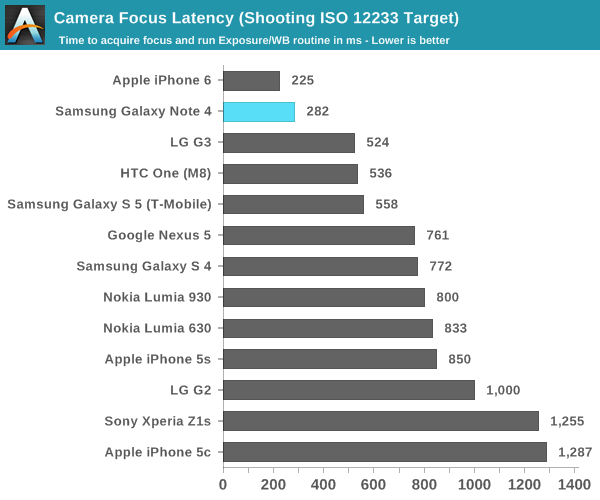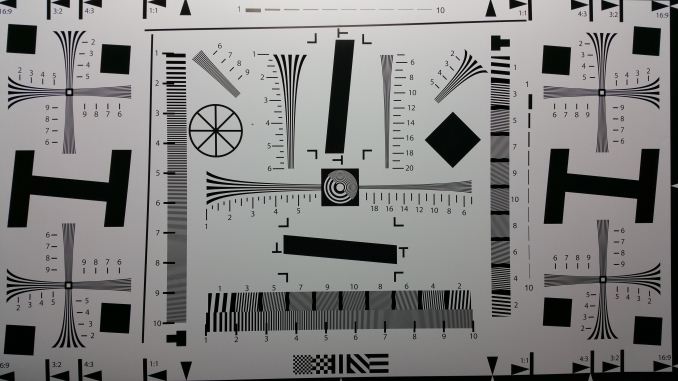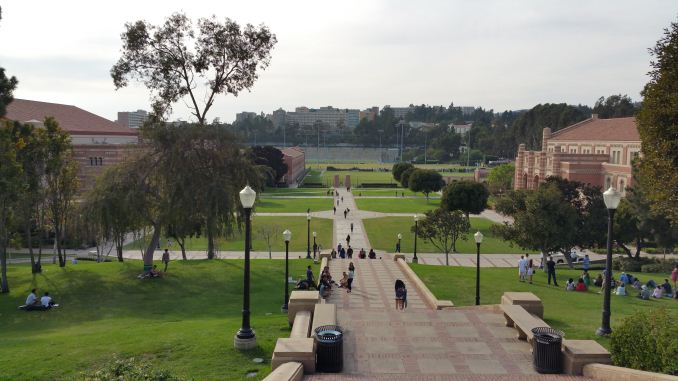The Samsung Galaxy Note 4 Review
by Joshua Ho on October 15, 2014 9:00 AM EST- Posted in
- Smartphones
- Samsung
- Android
- Mobile
- Galaxy Note 4
Camera
While the 16MP camera of the Galaxy Note 4 is mostly what we would expect, Samsung has really changed things up with the addition of OIS. Outside of this addition and the Sony IMX240 sensor, there’s really not a lot of change when it comes to the Galaxy Note 4. This means that we see the same 31mm equivalent focal length and F/2.27 aperture. At this point, it seems that OIS has finally reached mainstream adoption as both Samsung and Apple are shipping OIS solutions on their phones. The front facing camera is noticeably different though, with a Samsung S5K6D1YX sensor that I haven't seen elsewhere.
However, before we get into the proper image quality analysis I wanted to first cover shot to shot latency and focus/AE latency, as both are critical to a good image capture experience. Even if it’s possible to get amazing photos from a camera, it doesn’t really matter if the moment is missed. In order to test this, we look at the ideal case, which is when the phone is pointed at the ISO chart with bright lighting to maximize contrast.


As one can see in the graphs above, capture latency and focus latency are quite competitive with on the Note 4. However, there is one crucial detail that the focus latency graph misses, which is that Samsung doesn’t have continuous auto-focus in preview with the Note 4. As a result, there’s realistically an additional latency period before the auto-focus begins to run. The result is that the total time from out of focus to in focus is realistically closer to 800ms, but if one immediately taps the display to begin an AF run it’s possible to achieve the lower bound value, which is just south of 300ms.
Still Image Performance
While I'm still working on moving towards a better test for cameras, for now we have our standard photo comparisons that should give a good idea of what to expect from a smartphone camera in comparison to other cameras. Our first test is the standard ISO chart, which allows for a good test of maximum resolution.

For this first test, it seems that Samsung hasn't really changed much when it comes to maximum resolution, and in general the Note 4 produces similar output to the Galaxy S5. To verify this and a test of dynamic range, we'll look at a landscape shot next.
In this test, we see that the Galaxy Note 4 generally does well with detail and dynamic range as the landscape is generally well-detailed, although there's quite a bit of detail that seems to be smudged away on the grass as it seems to be a flat green texture for the most part. There's also noticeable color artifacting on the bleachers in the distance. We'll look at the same scene in low light to get a better idea for what the Note 4 really brings to the table.
Here, in low light we see significant improvements in image quality when comparing the Galaxy S5 to the Galaxy Note 4. The iPhone 6 Plus and Note 4 are quite close in overal quality, but looking at the brick building on the right of the image shows that the iPhone 6 Plus is maintaining a higher level of detail in this scene.
In the case of HDR, Samsung continues to do a great job with their implementation. For the most part this feature is successfully implemented with no real halos or other artifacts even when there are moving objects in the shot. This is likely to be implemented through on-sensor HDR rather than image combination.





































195 Comments
View All Comments
akdj - Wednesday, November 12, 2014 - link
I'm sure I'm being ignorant here, but how do I 'access' that satellite display?'Best option....the one built into Qualcomm's own modem...'
Is that an option already 'built in' or an app downloaded from the Play Store? I owned the original Note and couldn't get out of it quick ebough! Contract expired, I went in to look for my next dedicated business line (the original Note's responsibilities;)) --- & about thirty seconds with the Note 3 I caved. Bought it and I've enjoyed it daily without issue for almost 14 months now. It's paid off in two, and this review leaves me curious. Especially the display & it's 'relative' efficiency maintained in essentially the same package and by doubling it's resolution.
Something to be said for these sharper, HiDPI displays ...especially for those of us with 'aging eyes' ;) --- I couldn't be happier with this resolution push, and the good riddance to 3D!
Sorry, TL/DR
What is he using as an app for that screenshot in the GPS lock tool?
Thanks
NeatOman - Wednesday, October 15, 2014 - link
Curious to see the difference in battery life between 2.4Ghz Wireless N and Wireless AC, I've noticed a significant increase with my Nexus 5, and of course it was said the rest of the tests will be up later so that's cool.skinygeek - Wednesday, October 15, 2014 - link
No Word about the Exynos Variant? I was expecting a detailed analysis of the Exynos 5433. Was the Exynos version not provided to you for review?Laxaa - Wednesday, October 15, 2014 - link
I think the Exynos variant is the international one. I guess Samsung didn't send them one as it won't be out in the US.skinygeek - Wednesday, October 15, 2014 - link
Then they should have bought it . How hard it is to get an international variant of a device. There are websites which ship you these things. I don't expect such things from other websites, but Exynos 5433 marks a new Chapter in SOC's for Android phones for being the first high end A57+A53 CPU and i was expecting Anandtech to review hat SOC given their expertise in such things .Laxaa - Wednesday, October 15, 2014 - link
Hopefully, a comparison will be made at a later date if they get a hold of such a device. I agree that it will be interesting to see how if fares.extide - Wednesday, October 15, 2014 - link
Even though it's A57/A53 it is still locked down to 32-bit only :(gunsman - Wednesday, October 15, 2014 - link
but it will allow us to better quantify the addition of ARMv8 and 64 bit once ARMv8 enabled A57/A53 comes outKPOM - Wednesday, October 15, 2014 - link
Anandtech is still a U.S.-oriented site. And the 805 will be sold in more markets. There is plenty of data out there on the Exynos' performance. It isn't that good, which is why Samsung used the 805 in its most lucrative markets such as the US, EU, and Japan.heartinpiece - Thursday, October 16, 2014 - link
I disagree with the performance part, Some benchmarks show that the exynos 5433 surpasses the 805. The only reason 805 is used, (as far as I know) is the modem chips.a simple comparison:
805 Geekbench: of note 4
http://browser.primatelabs.com/geekbench3/780401
exynos 5433 geekbench of note4
http://browser.primatelabs.com/geekbench3/775316
Now i don't mean to say this benchmark shows the whole story.
But I am saying that 'it is that better'
Anandtech is a US oriented site, however for first A57+A53 SoC, it is well worth the review.